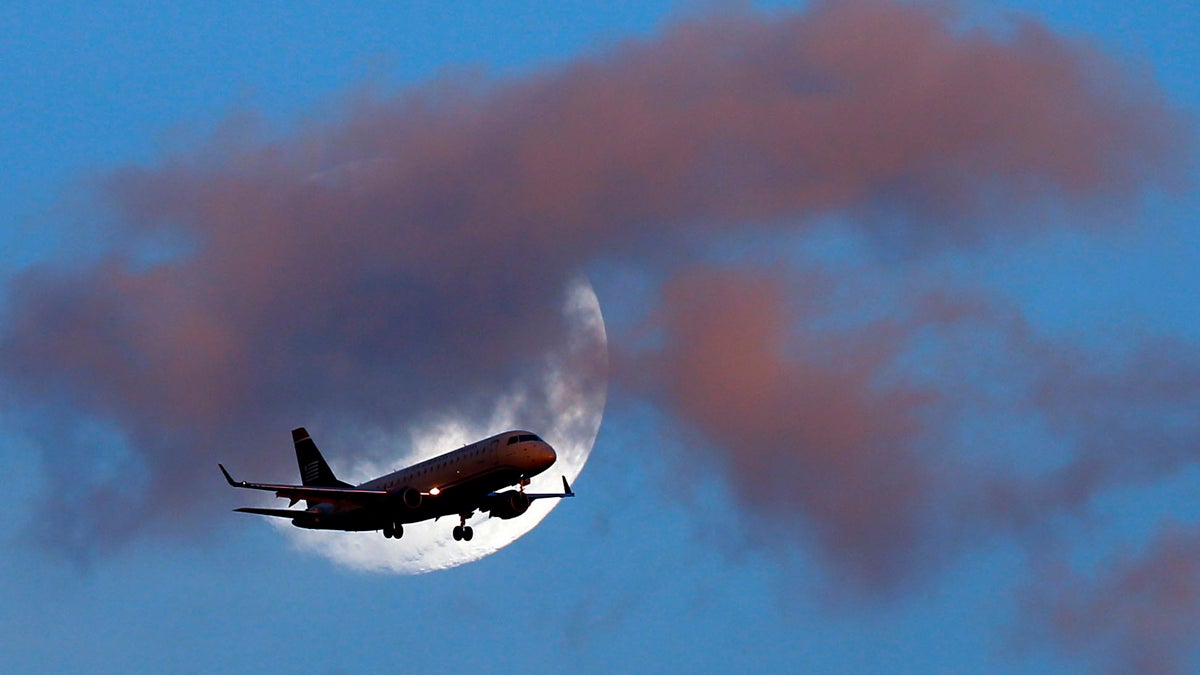Bird strikes, potential for Sully’s reality at Philly airport

An airplane passes the moon as it makes its approach to Philadelphia International Airport
A plane takes off from a busy urban airport and hits a flock of geese, forcing the pilot to make a harrowing, emergency landing in a river, the only place not packed with people and buildings.
It sounds like the stuff of movies — and in fact, it is.
“Sully,” which opens today, tells the true tale of “the Miracle on the Hudson,” a 2009 crash in which US Airways Capt. Chesley “Sully” Sullenberger landed a jet in the Hudson River, saving the lives of all aboard, after a bird strike disabled both its engines.
While high-drama crash landings that inspire Hollywood might not be common, bird strikes are such a frequent problem for pilots that the Federal Aviation Administration requires airports to report them.
At Philadelphia International Airport alone, for example, pilots have reported 1,408 bird strikes in the past decade, according to the FAA’s Wildlife Strike database. Other regional airports also have struggled with flight-foiling fowl: Newark Liberty International Airport reported 1,257 bird strikes in the past decade; Atlantic City International Airport, 474; Trenton-Mercer Airport, 65; and Northeast Philadelphia Airport, 17.
Because birds can down a plane, airports spend a lot money to keep them out of planes’ paths.
“We take it very seriously, because it can obviously be dangerous,” said Mary Flannery, a spokeswoman for Philadelphia International Airport.
For $250,000 a year, wildlife experts from the U.S. Department of Agriculture (USDA) keep birds at bay by removing nesting locations, chasing birds in vehicles, and mowing the grass to precise lengths (8 to 10 inches high — short enough to keep geese from nesting but long enough to hide rodents so predatory birds don’t swoop for snacks), Flannery said.
They also make noise to scare birds away. You might think the sound of dozens of roaring jet engines would be enough to frighten flocks away. But many birds who lurk near the airport have become desensitized to the rumble of aircraft, forcing wildlife-management workers to get creative.
“We use horns, sirens, and various noise makers like a small pistol, resembling a starter gun, that launches essentially a large firecracker. Different types makes different noises,” Flannery said. “We work to ‘mix up’ the noises to keep birds off guard.”
When bird strikes do happen, workers fish the remains out of engines (or wherever they hit) to identify bird breeds, which can then guide ongoing prevention efforts.
Some strikes, for example, can be tough to avoid no matter how much wildlife management happens on airport grounds. After an engine went out on a jet leaving Philly and forced its return on Dec. 13, for example, workers found the carcass of a snow goose in the engine and determined the plane hit the bird about 1,300 feet up and away from the airport, Flannery said.
The 159 reported bird strikes reported at the Philly airport in 2015 worked out to about three a week, up from about one a week a decade earlier, according to the FAA’s database. Flannery couldn’t say what drove the increase, saying improved reporting might have contributed.
Bird strikes have been an aviation headache since flight was invented, with Orville Wright reporting the first bird strike in 1905, according to the FAA.
More than half of all bird strikes happen from July to October, when young birds first leave their nests and fall migration occurs, according to the FAA. Gulls and waterfowl like ducks and geese are the most common birds hit by planes.
While bird strikes obviously are fatal to fowl, they can be deadly for humans too: 25 people died (and nearly 300 were injured) between 1990 and 2013 due to wildlife strikes with civilian planes, according to the FAA. Sixty-two planes were destroyed or damaged beyond repair by bird strikes during that same time period, the FAA found.
Beyond birds, other critters can get in airplanes’ way.
“We do occasionally have small rodents and rabbits,” Flannery said. “On the advice of USDA, we actually buried our perimeter fence 2 feet underground to prevent larger animals from gaining access.”
WHYY is your source for fact-based, in-depth journalism and information. As a nonprofit organization, we rely on financial support from readers like you. Please give today.

